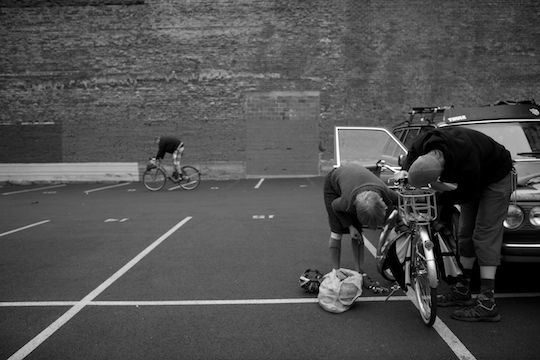You can engage people who look at your work more dimensionally if you decide whether to make the picture larger than the frame.
Huh?
The notion is pretty straightforward but explaining it is not so easy. The idea is that when people’s minds complete aspects of a photograph that don’t appear within the frame, the experience of looking at the photograph is more dimensional than when everything fits within the frame.
Here are two examples to show the difference. Both are photos I made.


In the first, all the critical elements are within the frame. In the second, aspects continue outside the frame - the car, the lines in the parking lot and to some extent, the wall. The action layer of each photograph is similar but the compositional approach is quite different.
A lot of people compose most of their frames more like the first image, to get everything in, to show the action/verb layer completely. And so most people make very similar images one situation to the next. This type of composition tends to be center weighted and the further from the center, the less essential things become.
So not only is everything self contained in the first photo, it’s also a one dimensional photo - nothing ahead of or behind the verb layer is really important, nor does your eye engage much in either direction.
In the second photo, the eye travels deep into the frame to the second bike, your mind completes the rest of the Mercedes and may wonder how large that wall is and extends the lines of the parking lot to a logical concluding point.
Compare the geometry of the two pictures and see how many different triangular planes of connection there are.
I generally think the second type of picture is more successful, more engaging. But that doesn’t mean the first type is without value. There should be all manner of range in the types of images you make, including the self-contained photo.
If you only make the first kind of picture, that’s a problem because those images tend to be singular in their ability to engage. They are ones; they tend to work on only one level; they are this photos, when the greater potential is to deal with this and that in one image. So when connected one image to the next these singular images will only equal the number of images.
The second type of image engages more dynamically and typically presents a this and that aspect to a subject, a scene. They are at least twos. So when this compositional approach in images is connected one image to the next, the sum of the images is greater than their number.
You’ll also notice that in the first photo, the critical elements are in the middle of the frame and the further you go from the middle, the less there is. In the second photo, the middle of the frame is empty and critical elements exist in several parts of the frame.
@ Tim, your quesiton about portraiture is a good one. Clearly, amazing photographs can be made, have been made that are center-based or that don't have elements continuing outside the frame. The critical things to understand is when to break the frame and when not to and knowing the difference.
